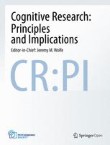Cognitive Research: Principles and Implications is affiliated with The Psychonomic Society
The range of confidence scales does not affect the relationship between confidence and accuracy in recognition memory
Researchers use a wide range of confidence scales when measuring the relationship between confidence and accuracy in reports from memory, with the highest number usually representing the greatest confidence (e...
